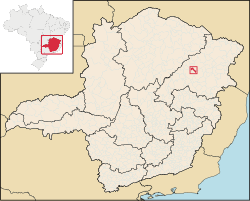Jenipapo de Minas: Difference between revisions
link subsistence agriculture using Find link |
Rescuing 2 sources and tagging 0 as dead. #IABot (v1.3beta8) |
||
| Line 3: | Line 3: | ||
'''Jenipapo de Minas''' is a municipality in the northeast of the Brazilian state of [[Minas Gerais]]. As of 2007 the population was 6,905 in a total area of 284 km². The elevation of the town center is 521 meters. It is part of the IBGE statistical meso-region of [[Jequitinhonha]] and the micro-region of [[Capelinha]]. It became a municipality in 1997. |
'''Jenipapo de Minas''' is a municipality in the northeast of the Brazilian state of [[Minas Gerais]]. As of 2007 the population was 6,905 in a total area of 284 km². The elevation of the town center is 521 meters. It is part of the IBGE statistical meso-region of [[Jequitinhonha]] and the micro-region of [[Capelinha]]. It became a municipality in 1997. |
||
The economy is based on charcoal production, cattle raising and [[subsistence agriculture]], with the main crops being beans, manioc, sugarcane, and corn. There are extensive plantations of eucalyptus trees for charcoal production. In 2005 there were 642 rural producers but only 5 tractors. As of 2005 there were 3 public health clinics. Educational needs were met by 15 primary schools and 1 middle school. There were 64 automobiles in 2006, giving a ratio of 107 inhabitants per automobile (there were 293 motorcycles). There were no banks in 2007.<ref>[http://www.ibge.gov.br/cidadesat/default.php IBGE]</ref> |
The economy is based on charcoal production, cattle raising and [[subsistence agriculture]], with the main crops being beans, manioc, sugarcane, and corn. There are extensive plantations of eucalyptus trees for charcoal production. In 2005 there were 642 rural producers but only 5 tractors. As of 2005 there were 3 public health clinics. Educational needs were met by 15 primary schools and 1 middle school. There were 64 automobiles in 2006, giving a ratio of 107 inhabitants per automobile (there were 293 motorcycles). There were no banks in 2007.<ref>[http://www.ibge.gov.br/cidadesat/default.php IBGE] {{webarchive|url=https://web.archive.org/web/20070109005631/http://www.ibge.gov.br/cidadesat/default.php |date=2007-01-09 }}</ref> |
||
Neighboring municipalities are: [[Araçuaí]] and [[Francisco Badaró]]. The distance to [[Belo Horizonte]] is 734 km.<ref>[http://www.aondefica.com/centerleft_mg.asp Distancias Minas Gerais]</ref> |
Neighboring municipalities are: [[Araçuaí]] and [[Francisco Badaró]]. The distance to [[Belo Horizonte]] is 734 km.<ref>[http://www.aondefica.com/centerleft_mg.asp Distancias Minas Gerais]</ref> |
||
| Line 16: | Line 16: | ||
*Literacy rate: 64 |
*Literacy rate: 64 |
||
*Combined primary, secondary and tertiary gross enrolment ratio: .763 |
*Combined primary, secondary and tertiary gross enrolment ratio: .763 |
||
*Per capita income (monthly): R$84.00<ref name="Frigoletto">[http://www.frigoletto.com.br/GeoEcon/idhmg.htm Frigoletto]</ref> |
*Per capita income (monthly): R$84.00<ref name="Frigoletto">[http://www.frigoletto.com.br/GeoEcon/idhmg.htm Frigoletto] {{webarchive|url=https://web.archive.org/web/20110706152853/http://www.frigoletto.com.br/GeoEcon/idhmg.htm |date=2011-07-06 }}</ref> |
||
The above figures can be compared with those of [[Poços de Caldas]], which had an MHDI of .841, the highest in the state of [[Minas Gerais]]. The highest in the country was [[São Caetano do Sul]] in the state of [[São Paulo]] with an MHDI of .919. The lowest was [[Manari, Brazil|Manari]] in the state of [[Pernambuco]] with an MHDI of .467 out of a total of 5504 municipalities in the country as of 2004. At last count Brazil had 5,561 municipalities so this might have changed at the time of this writing.<ref name="Frigoletto"/> |
The above figures can be compared with those of [[Poços de Caldas]], which had an MHDI of .841, the highest in the state of [[Minas Gerais]]. The highest in the country was [[São Caetano do Sul]] in the state of [[São Paulo]] with an MHDI of .919. The lowest was [[Manari, Brazil|Manari]] in the state of [[Pernambuco]] with an MHDI of .467 out of a total of 5504 municipalities in the country as of 2004. At last count Brazil had 5,561 municipalities so this might have changed at the time of this writing.<ref name="Frigoletto"/> |
||
Revision as of 03:18, 21 April 2017

Jenipapo de Minas is a municipality in the northeast of the Brazilian state of Minas Gerais. As of 2007 the population was 6,905 in a total area of 284 km². The elevation of the town center is 521 meters. It is part of the IBGE statistical meso-region of Jequitinhonha and the micro-region of Capelinha. It became a municipality in 1997.
The economy is based on charcoal production, cattle raising and subsistence agriculture, with the main crops being beans, manioc, sugarcane, and corn. There are extensive plantations of eucalyptus trees for charcoal production. In 2005 there were 642 rural producers but only 5 tractors. As of 2005 there were 3 public health clinics. Educational needs were met by 15 primary schools and 1 middle school. There were 64 automobiles in 2006, giving a ratio of 107 inhabitants per automobile (there were 293 motorcycles). There were no banks in 2007.[1]
Neighboring municipalities are: Araçuaí and Francisco Badaró. The distance to Belo Horizonte is 734 km.[2]
Social Indicators
Jenipapo de Minas is ranked low on the MHDI and was one of the poorest municipalities in the state and in the country in 2000.
- MHDI: .618 (2000)
- State ranking: 809 out of 853 municipalities
- National ranking: 4,349 out of 5,138 municipalities in 2000
- Life expectancy: 64
- Literacy rate: 64
- Combined primary, secondary and tertiary gross enrolment ratio: .763
- Per capita income (monthly): R$84.00[3]
The above figures can be compared with those of Poços de Caldas, which had an MHDI of .841, the highest in the state of Minas Gerais. The highest in the country was São Caetano do Sul in the state of São Paulo with an MHDI of .919. The lowest was Manari in the state of Pernambuco with an MHDI of .467 out of a total of 5504 municipalities in the country as of 2004. At last count Brazil had 5,561 municipalities so this might have changed at the time of this writing.[3]
References
- ^ IBGE Archived 2007-01-09 at the Wayback Machine
- ^ Distancias Minas Gerais
- ^ a b Frigoletto Archived 2011-07-06 at the Wayback Machine
See also
17°04′58″S 42°15′28″W / 17.08278°S 42.25778°W

